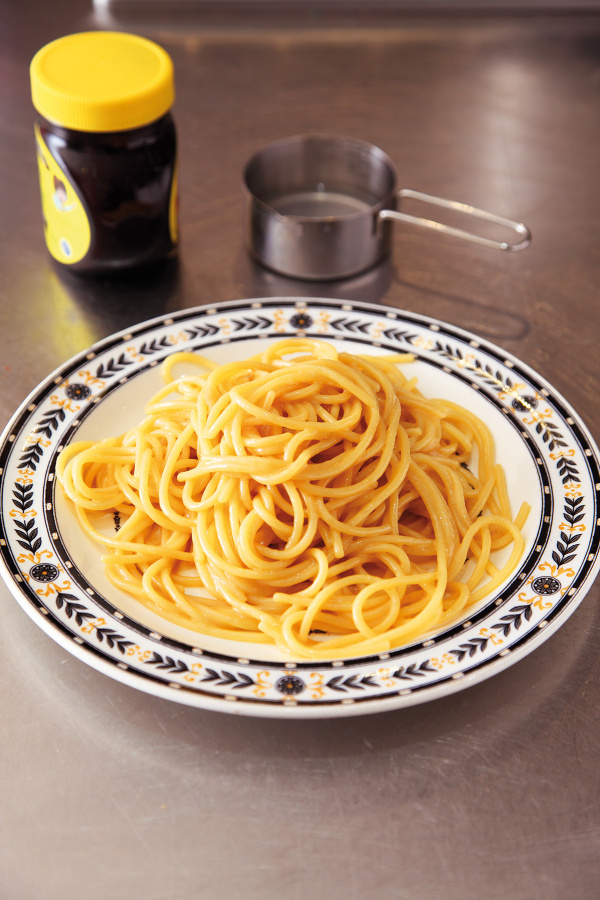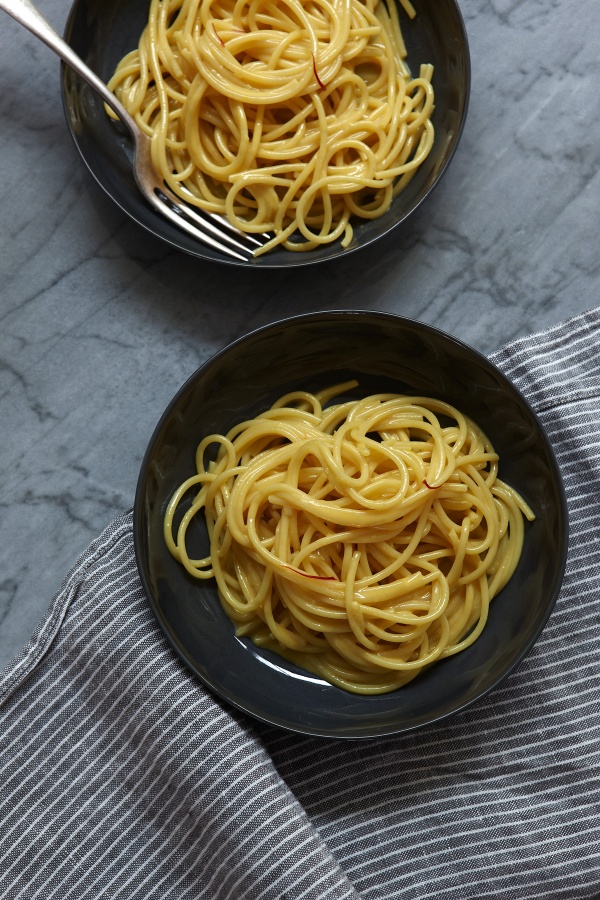Linguine With Mussels
by Nigella. Featured in NIGELLA SUMMERIntroduction
You might label this shiny black musselled variation of linguine alle vongole, linguine alle cozze, but to be frank, this version is not very Italian-flavoured. It owes something to the French taste for moules mariniere, and reaches Spainwards for a slug of sherry, in place of the usual white wine, to add oomph to the molluscs' briney juices.
You might label this shiny black musselled variation of linguine alle vongole, linguine alle cozze, but to be frank, this version is not very Italian-flavoured. It owes something to the French taste for moules mariniere, and reaches Spainwards for a slug of sherry, in place of the usual white wine, to add oomph to the molluscs' briney juices.

Share or save this
Ingredients
Serves: 2
- 500 grams mussels
- salt
- 250 grams linguine
- 3 tablespoons olive oil
- 1 clove garlic (cut into shards)
- 1 long fresh red chilli pepper (deseeded and cut into strips)
- 100 millilitres amontillado sherry
- 3 tablespoons chopped fresh parsley
- 1 pound mussels
- salt
- 8 ounces linguine
- 3 tablespoons olive oil
- 1 clove garlic (cut into shards)
- 1 long fresh red chile pepper (deseeded and cut into strips)
- 7 tablespoons amontillado sherry
- 3 tablespoons chopped fresh parsley
Method
- Put the mussels to soak in a sinkful of cold water — using a knife to scrape off any bits of beard or barnacle that cling to the shells — while you heat the water for the pasta. When the water comes to the boil, add salt and then, when boiling again, the linguine. Cook them until nearly ready: you're going to give them a minute or so later to continue cooking with the mussels and their briney, winey juices.
- So, while the pasta's cooking, drain the mussels, discarding those that remain open when you rap the shells, and sit them in a colander for a while. Get out a large pan (big enough to fit all the pasta in later) and pour in the oil. Add the garlic shards and strips of chilli pepper and heat over a lowish flame till warmly sizzling, but don't let the garlic brown or it will become bitter and acrid. Tip the mussels clatteringly into the garlic and chilli pan, turn up the heat, pour in the sherry and clamp shut with a lid. Shake the pan a couple of times, just to disperse the heat, but not so much that you fracture the shells. In a few minutes, the mussels should be steamed open; any that stay resolutely shut are bad and you must just pick through them and throw them away.
- Add the drained, almost-cooked pasta, put the lid on again and swirl about. In another minute or so, the pasta will have cooked to the requisite tough tenderness — the joy of linguine is that it keeps a certain robust and satisfying chewy mouth-fillingness — and will have absorbed much of the garlicky, smokey-sherried mussel juices, and be swellingly bound in a wonderful Riviera-redolent sea syrup. But if the pasta looks like it needs a little more time, just shove the lid on again and give it another minute or so. The thing here is to let everything, quite simply, come together.
- Add half the parsley, shake the pan to distribute evenly, and turn into a large bowl, sprinkling, finally, with the rest of the parsley. You do not offer cheese with this pasta; I am not generally good with authority, but some rules — such as the Italian one that forbids the addition of cheese to any pasta sauce containing fish — hold good.
- Put the mussels to soak in a sinkful of cold water — using a knife to scrape off any bits of beard or barnacle that cling to the shells — while you heat the water for the pasta. When the water comes to the boil, add salt and then, when boiling again, the linguine. Cook them until nearly ready: you're going to give them a minute or so later to continue cooking with the mussels and their briney, winey juices.
- So, while the pasta's cooking, drain the mussels, discarding those that remain open when you rap the shells, and sit them in a colander for a while. Get out a large pan (big enough to fit all the pasta in later) and pour in the oil. Add the garlic shards and strips of chilli pepper and heat over a lowish flame till warmly sizzling, but don't let the garlic brown or it will become bitter and acrid. Tip the mussels clatteringly into the garlic and chilli pan, turn up the heat, pour in the sherry and clamp shut with a lid. Shake the pan a couple of times, just to disperse the heat, but not so much that you fracture the shells. In a few minutes, the mussels should be steamed open; any that stay resolutely shut are bad and you must just pick through them and throw them away.
- Add the drained, almost-cooked pasta, put the lid on again and swirl about. In another minute or so, the pasta will have cooked to the requisite tough tenderness — the joy of linguine is that it keeps a certain robust and satisfying chewy mouth-fillingness — and will have absorbed much of the garlicky, smokey-sherried mussel juices, and be swellingly bound in a wonderful Riviera-redolent sea syrup. But if the pasta looks like it needs a little more time, just shove the lid on again and give it another minute or so. The thing here is to let everything, quite simply, come together.
- Add half the parsley, shake the pan to distribute evenly, and turn into a large bowl, sprinkling, finally, with the rest of the parsley. You do not offer cheese with this pasta; I am not generally good with authority, but some rules — such as the Italian one that forbids the addition of cheese to any pasta sauce containing fish — hold good.
Additional Information
MAKE AHEAD / STORE:
It is not advisable to make ahead or store.
MAKE AHEAD / STORE:
It is not advisable to make ahead or store.







Tell us what you think
Thank you {% member.data['first-name'] %}.
Explore more recipesYour comment has been submitted.
What 1 Other has said
-
Posted by Jacquie7107 on 13th September 2013
Show more commentsSo delicious! And super simple! Thank you, my husband enjoyed it as well.